| Last comments - Pharsalos |

1650 Hadrian Sestertius, Roma 130-38 AD Dacia Reference.
RIC II, 849; Strack 715: RIC 1650; Banti 237
Bust C2
Obv. HADRIANVS AVG COS III P P
Laureate, draped, bust viewed from side
Rev. S C in field; DACIA in ex.
Dacia seated left, on pile of rocks, with foor on helmet, holding standard and falx (curved sword)
26.93 gr
34 mm
12hokidoki09/27/20 at 11:35Pharsalos: Not a ‘travel’ type you see often, beautiful.
|
|

Constantine I the Great. Eyes Raised Siliqua of Constantinople.Roman Empire. Constantine I. 306-337 AD. AR Siliqua (2.48 gm, 18.7mm, 12h) of Constantinople, 326 AD. Head right with rosette-diadem, looking upwards. / Victory standing left holding wreath and palm, CONSTANTINVS AVG. ex: CONS. nEF. Flan crack. Bt. Guy Clark, Charlotte, 2010. RIC VII p.570 #5; RSC V #97k; SRCV IV #15848.Anaximander09/27/20 at 11:27Pharsalos: Stunning coin, beautiful dies and toning.
|
|

1282 Hadrian Sestertius Roma 129-30 AD Galley leftReference.
RIC II –; RIC II.3 1282 (this coin referenced and illustrated); Strack –;Banti –.
Bust C2
Obv. HADRIANVS AVGVSTVS
Laureate, draped bust, viewed from side
Rev. FELICITATI AVG COS III P P in three lines above, S C across field
Galley moving left with stearman and six rowers; vexillum on prow.
27 gr
32.50 mm
12h
Note.
From the Toliver Besson Collection, purchased from Jon Jencek (14 December 2012). Ex Goldberg 5.3 (7 June 2000), lot 3582; Earl Fitzwilliam’s Wentworth Estates Company Collection (Christie’s, 30 May 1949), lot 124 (part of).
This very rare Hadrian Sestertius was part of the highly important collection of Roman Brass Coins and Medallions originally formed in the mid-eighteenth century, and sold by order of The Earl Fitzwilliam’s Wentworth Estates Company. Spring notes that the coins came from the collections of the Museo del Padri Corsini acquired in Italy in 1748, and the Abbé Visconti, President of the Society of Antiquaries in Rome, purchased about 1774.okidoki09/27/20 at 11:23Pharsalos: Agreed, that is an amazing coin!
|
|

2370 Hadrian Sestertius, Roma 130-38 AD AequitasReference.
RIC 2370; RIC II, 743; Strack 650; C. 125; Banti 85
Bust A2
Obv. HADRIANVS AVG COS III P P
Laureate head with drapery
Rev. AEQVITAS AVG S C in field.
Aequitas standing left, holding scales and sceptre
23.69 gr
31 mm
6h
Note.
Philippe Rossignol collectionokidoki09/27/20 at 11:22Pharsalos: Beautiful portrait.
|
|

Constantius II. Roma facing Constantinopolis Solidus of ThessalonicaRoman Empire. Constantius II. 337-361 AD. AV Solidus (4.20 gm, 22.3mm, 12h) of Thessalonica, 353-355 AD Pear diadem, draped, & cuirassed bust right, DN CONSTANTIVS MAX AVGVSTVS. / Roma enthroned left, facing Constantinopolis, foot on prow, holding sceptres and shield inscribed VOT XXX MVLT XXXX; GLORIA REIPVBLICAE. ex: ⦁TES⦁. EF. Ponterio Numismatics Auction 123 #387. RIC VIII p.416 #150; Cohen 122; SRCV V #17751.Anaximander09/27/20 at 11:21Pharsalos: Very impressive  ! !
|
|

Constantius II. Votis XXX Siliqua of Sirmium.Roman Empire. Constantius II. 337-361 AD. AR Siliqua (3.02 gm, 21.1mm, 12h) of Sirmium, 353-355 AD. Pearl diadem, draped & cuirassed bust right, D N CONSTANTIVS P F AVG. / VOTIS XXX MVLTIS XXXX in four lines within wreath. Ex: SIRM (no dot or crescent). EF. Bt. Coral Gables, 2001. RIC VIII p.385 #15; RSC V #343e; SRCV V #17936.Anaximander09/27/20 at 11:15Pharsalos: Beautiful Siliqua!
|
|

077 - Severus Alexander denarius - RIC 246Obv:– IMP ALEXANDER PIVS AVG, Laureate head right
Rev:– MARS VLTOR, Mars advancing right, holding a spear and shield
Minted in Rome, A.D. 232
References:– RIC 246, RSC 161a
This was my first ancient coin and is still one of my favourites.
3.64gms. 19.91mm. 180 degrees maridvnvm09/27/20 at 11:12Pharsalos: Great first coin!! Beautiful details both sides, l...
|
|

Marcus Aurelius. Restoration Galley issue. Denarius.Roman Empire. Marcus Aurelius & Lucius Verus. 161-169 AD. AR Denarius (2.76 gm, 20.0mm, 12h) of Rome 165-166 AD. Restoration issue of Marc Antony legionary type. Praetorian galley left. ANTONINVS AVGVR III VIR R P C. / Legionary eagle (aquila) between two standard (signa). ANTONIVS ET VERVS AVG REST; LEG VI across field. gVF. CNG Auction 114 #903. From the Benito Collection. See in Benito's Forum Gallery. Ex-Spink. RIC III #443 (Aurelius and Verus); Beckmann, Restoration, dies o27/r25; MIR 18, 120-4 (Aurelius); RSC 83 (Antony); SRCV II #5236.Anaximander08/30/20 at 06:37Pharsalos: Wow, a scarce type in any condition but that is ju...
|
|

THESSALY, Pharsalos. Late 5th-mid 4th century BCAR Drachm
O: Helmeted head of Athena right, sphinx on bowl; T/Θ behind neck guard
R: Warrior on horseback right, wearing petasos, holding mace overhead; T in exergue; all within incuse square.
5.59g
19mm
Lavva 144 (V68/R84); BCD Thessaly II 645.
Ex. Solidus Auction 59, part of lot 1028
Mat08/09/20 at 10:42Pharsalos: A beautiful, interesting drachm!
|
|

HyriaCAMPANIA, Hyrianoi. Circa 405-400 BC. AR Nomos (21.5mm, 7.55 g, 2h). Helmeted head of Athena left / Man-headed bull standing right. Rutter 46 (O26/R40); HN Italy 539.
from the Baldwin Maull collection, CNG e-sale 452, 18 September 2019, lot 11; Stacks, 30 January 1958, lot 1; from the Polese collection, Canessa V, 12 June 1928, lot 2807/30/20 at 14:20Pharsalos: Wonderful coin and provenance.
|
|
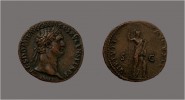
Domitian (81-96 AD)Denomination: AE As
Date: 90-91 AD
Obv: IMP CAES DOMIT AVG GERM COS XV CENS PER P P, laureate head right.
Rev: VIRTVTI AVGVSTI, SC across field, Virtus standing right, holding parazonium and sceptre, left foot on helmet.
Diameter: 28mm
Weight: 11.40 grams
Mint: Rome
Ref: RIC II 709
Ex: Calgary CoinRomancollector07/30/20 at 14:11Pharsalos: Beautiful coin, fantastic obverse.
|
|

Siciliy - Messana Zancle Incuse DrachmMessana under Zancle Drachm
Sicile, Messana sous le nom de Zancle, 520-493 av. J.C. AR Drachme 5.44g.
D:/DANKL(E) le port sous la forme d'une faucille. à l'intérieur un dauphin nageant à g.
R:/même type incus.
ref. HGC Sicily 767, Gorini p.33 n°2, SNG Ashmolean museum 1817 (ex Lockett collection, mêmes coins)
Brennos07/25/20 at 11:34Pharsalos: Wow, spectacular! Great provenance too.
|
|
|
|

BRUTTIUM, Carthaginian occupation. Circa 215-205 BC. AR Half Shekel (19.5mm, 3.60 g, 3h)BRUTTIUM, Carthaginian occupation. Circa 215-205 BC. AR Half Shekel (19.5mm, 3.60 g, 3h). Wreathed head of Tanit left / Horse standing right; solar disk above. Jenkins, Some U1; Robinson, Second p. 44, 3; CNP 44c; HN Italy 2016. Toned, minor deposits, struck with worn reverse die. Good VF.
From the Weise Collection, purchased from Atlantis Ltd., 24 October 2004.Mark R107/25/20 at 11:23Pharsalos: Beautiful.
|
|

RIC 118 var.Denarius, 103-111
Obv: IMP TRAIANO AVG GER DAC P M TR P
Laur. r., dr. and cuirassed.
Rev: COS V P P S P Q R OPTIMO PRINC
Aequitas standing l., holding scales and cornucopiae.
3.16g, 18mm
Woytek 278h (1 specimen, no picture)
klausklage07/25/20 at 11:22Pharsalos: Fantastic obverse bust.
|
|

Constantius II, 22 May 337 - 3 November 361 A.D.Billon heavy maiorina, RIC VIII Antioch 132, LRBC II 2625, SRCV V 18171, Hunter V 127 var. (10th officina), Choice gVF, dark patina, lighter highlighting deposits, slight double strike, part of edge ragged, 12th officina, Antioch (Antakya, Turkey) mint, weight 6.098g, maximum diameter 26.3mm, die axis 180o, 350 - 355 A.D.; obverse D N CONSTANTIVS P F AVG, pearl-diademed, draped, and cuirassed bust right; reverse FEL TEMP REPARATIO (happy times restored), soldier standing left, shield on left arm, spear in right hand, spearing bearded fallen horseman who is turned to face the shoulder and extends his left arm, shield on ground right, Γ (control symbol) upper left, ANBI in exergue; from the Errett Bishop Collection.
Superb exceptional Reverse.
FORVM Ancient Coins / The Sam Mansourati Collection.
In 354, Constantius II recalled his legate (and cousin) Constantius Gallus to Constantinople after receiving unfavorable reports about him. Caesar of the East, Gallus had successfully suppressed revolts in Palestine and central Anatolia. Constantius stripped him of his rank and later had him executed in Pola (in modern Croatia).Sam07/25/20 at 11:21Pharsalos: Lovely example, great reverse details.
|
|
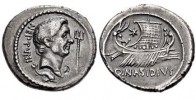
0001 Sextus Pompey, Imperator and Prefect of the Fleet [Youngest Son of Gnaeus Pompeius Magnus (Pompey the Great)]Q. Nasidius for Sextus Pompey
Obv: NEPTVNI (open P) downward on the l., bareheaded portrait of Gnaeus Pompeius Magnus facing r., trident with prongs pointing upward on the r., dolphin facing r. below neck, banker's mark to r. of bottom of neck. Border of dots.
Rev: Q. NASIDIVS below galley moving r. with billowing sail and bank of rowers, steersman on l. facing r. on stern with star above, pilot on r. facing r. standing on prow. Border of dots.
Denomination: silver denarius; Mint: Sicily, uncertain location1; Date 42 BC2; Weight: 3.87g; Diameter: 19mm: Die axis: 150º; References, for example: Cohen 15; Babelon Nasidia 1 and Pompeia 28; BMCRR v. II Sicily 21; Crawford RRC 483/2; Sydenham 1350; CRI 235.
Notes:
Q. Nasidius, a naval commander under Pompey the Great, eventually wound up in the services of Sextus. See Grueber BMCRR v. II Sicily p. 564 and Sear CRI pp. 139 - 140.
1Sydenham, Crawford RRC, and Estiot (2006) place the minting of this coin type in Sicily, but without referencing a location. Grueber BMCRR v. II Sicily also places the minting of this coin in Sicily and hesitatingly suggests the city of Catana. By his own admission "...this attribution is quite conjectural" (p. 557). Sear CRI, however, argues for a completely different location. On the basis of the naval theme and the absence of the title PRAEF⦁ORAE⦁MARIT⦁ET⦁CLAS⦁S⦁C, which for him pushes the date of minting to a time prior to April of 43 BC, Sear posits the minting of this coin to Sextus' time at the port of Massilia in southern Gaul.
2This is the date argued for in Estiot (2006) (p. 145), "...possibly around the time just before the beginning of the issue of Sextus Pompieus" imp. iter. praef. clas. et orae marit ex S C. coinage" [translation my own]. Grueber BMCRR v. II Sicily proposes 38 - 36 BC with Sydenham and DeRose Evans (1987) following suit. Crawford RRC suggests 44 - 43 BC.
Provenance: Ex CNG Auction 114 May 13, 2020 Lot 646; From the B. G. Collection, Ex CNG Auction 108 May 16, 2018 Lot 526.
Photo Credits: CNG
CLICK FOR SOURCESTracy Aiello07/25/20 at 11:11Pharsalos: Beautiful example of an historic type.
|
|

0244 - Denarius Hadrian 126-7 ACObv/ HADRIANVS AVGVSTVS, laureate and draped head of H. r.
Rev/ Virtus l. seated on throne of shield and cuirass, holding spear and parazonium; around, COS III.
Ag, 18.9 mm, 3.22 g
Mint: Rome.
RIC II.3/860 [C] - BMCRE III/367
ex-Roma Numismatics, auction e62, lot 876 (ex-G.R.Arnold colln., Glendining 17-8/6/1969, #482).dafnis07/25/20 at 11:10Pharsalos: Exceptional denarius!
|
|

RIC 264, ROMAN IMPERATORIAL, Octavian, AR DenariusRome, The Imperators.
Octavian, 44-27 BCE.
AR Denarius (3.82g; 19mm).
Italian Mint, ca. 30 BCE.
Obverse: Victory standing on prow holding wreath and palm, facing right.
Reverse: Octavian, holding branch, in slow triumphal quadriga advancing right; IMP CAESAR in exergue.
References: HCRI 416; RIC 264; BMCRR 4343; Julia 154.
Provenance: Ex NAC Spring 2020 Sale (25 May 2020) Lot 761; UBS 78 (2008) Lot 1232; Munzhandlung Basel Auction 6 (18 Mar 1936) Lot 1514.
Following the defeat of Antony by Octavian and Agrippa at Actium, Octavian was undisputed leader of the Mediterranean world. By 30 BCE, Octavian had taken complete control of Egypt and the Ptolemaic treasury. The Ptolemaic treasury provided the silver with which Octavian would strike much of his IMP CAESAR coinage of this period both to pay-off his retiring legionary veterans and to fund celebrations in Rome. The obverse of this coin, with Victory standing on a ship’s prow, clearly celebrates the naval victory at Actium. The reverse may depict Octavian’s triumphal entrance into Alexandria. A similar type with CAESAR DIVI F legend was struck in much smaller quantities, likely before the Ptolemaic bullion was moved to Rome.
Carausius07/25/20 at 11:06Pharsalos: Beautiful example with a great provenance. Great d...
|
|

Troas - NeandreaAR hemiobol
c.350-340 BC
O - Head of Apollo right
R - Oinochoe
mauseus07/25/20 at 11:02Pharsalos: Wow, a rare little coin. I think the title should ...
|
|

0001 Bull Hoof (Seen From Below) and Bridled Horse Facing LeftThessaly Greece, the City of Larissa
Obv: bull hoof seen from below. All within a border of dots.
Rev: ΛΑ in front and down to the l., head and neck of a bridled horse l. All within incuse square.
Denomination: silver hemiobol; Mint: Larissa; Date: 462 - 460 BC1; Weight: .40g; Diameter: 7.8mm: Die axis: 0º; References, for example: Liampi Corpus Group II 2 (V2/R1); Triton XIV 103; BCD Thessaly 1107.
Notes:
1This is the date provided in BCD Thessaly and Triton XIV.
Provenance: Ex Apollo Numismatics July 4, 2020.
Photo Credits: Apollo Numismatics
CLICK FOR SOURCES
Tracy Aiello07/25/20 at 10:53Pharsalos: Wonderfully detailed.
|
|

Cr 39/4 Æ Uncia Anonymousc. 217-215 B.C.E. Rome
Radiate and draped facing bust of Sol; • (value) to left
Crescent; two stars and • (value) above; ROMA below
24mm 12.47 gm
ex. McCabe; ex RBW
This large "unit" of the semilibral standard comes from the series sometimes also described as "collateral", "anomalous", and, painfully, "anomalous anonymous". Crawford identified only struck bronzes from Triens to Semuncia for this issue. There are no clearly-associated cast bronze larger denominations, with the nearest-dated such cast types having more directly-related struck smaller denominations.
Yet, this series demonstrates the last great gasp of creativity in Republican bronze, no Prows in sight and without standardized presentations of the soon-to-be-rigid obverse gods.
Although not rare, these interesting types do not show up in every sale. This specimen has a bit of roughness but also a wonderful strike.PMah07/25/20 at 09:21Pharsalos: Beautiful example of a beautiful type.
|
|
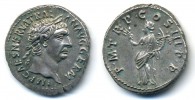
RIC 38Denarius, 100
Obv: IMP CAES NERVA TRAIAN AVG GERM
Laur. r.
Rev: P M TR P COS III P P
Pax standing l. holding branch and cornucopiae.
3.54g, 19mm
Woytek 75a (53 specimen)klausklage02/25/20 at 09:04Pharsalos: Beautiful denarius.
|
|

Greek, Italy, Calabria, Taras AR Nomos. 280-272 BC20.5mm, 6.46 g, 2h
Reduced standard. Nude youth, crowing horse he rides right; to left, crowing Nike above ΣI; ΘE below / Phalanthos, nude, holding kantharos and trident, riding dolphin left; ΛY to right. Vlasto 759; HN Italy 1009. Toned, deposits, cleaning scratches in fields on obverse. EF. Very rare, only the Vlasto example in CoinArchives.
From the Matthew Curtis Collection.Leo02/25/20 at 08:54Pharsalos: What a strike! The detail in the obverse is extrao...
|
|

169 - Constans - AE2 - RIC VIII Antioch 124 corr var AE2
Obv:- D N CONSTA-NS P F AVG, Pearl diademed, draped & cuirassed bust right
Rev:- FEL TEMP-REPARATIO, Emperor in military dress standing left on galley, holding Phoenix and labarum, Victory sitting at the stern, steering the ship. Prow decorated with trident
Minted in Antioch; (_ | * //ANH), A.D. 348-350
Reference:– RIC VIII Antioch 124 corr (* in right field not left as indicated in RIC) var (Unlisted officina, others Rated S)
5.19g, 23.48mm, 180omaridvnvm11/02/19 at 21:54Pharsalos: Magnificent, beautiful bust and exceptionally deta...
|
|
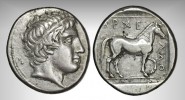
Archelaos. 413-399 BC. Macedon, Archelaos. 413-399 BC. AR Pentadrachm (10.64 gm, 24mm, 8h) Aigai or Pella, Reduced Light Thraco-Mac. stdd. Head of Apollo (or Ares) wearing tainia, r. / Horse standing r., foreleg raised, trailing bridle. ΑΡΧΕ-ΛΑΟ. VF. SNG ANS 8 #65-69. HGC 3.1 #795; ACNAC: Davis 75, Dewing 1093; Kraay ACGC plate 28 #505; Price Macedonians 51; SNG Alpha Bank 146-148; SNG Berry 75; SNG Cop 2 #503; SNG Delepierre 941; Westermark Grp II Series 2 (O90/R112). cf. Sotheby's 6417 #205. Anaximander10/21/19 at 07:25Pharsalos: Another amazing coin, beautifully rendered horse.
|
|

Demetrios I Poliorketes. 306-285 BC. AR Tetradrachm Pella Macedon, Demetrios I Poliorketes. 306-285 BC. AR Tetradrachm (17.40 gm, 29mm, 11h) of Pella 294-292 BC. Winged Nike stdg l. on prow of galley, blowing trumpet & holding stylis. / Poseidon Pelagaios advancing l. w/ trident. ΔΗΜΗΤΡΙΟΥ ΒΑΣΙΛΕΩΣ. ɪΩ monogram to l.; dolphin above to r. EF. Lustrous. Newell DP 68 (obv. die LVII, plate VI #18); ACNAC Dewing #1196; HGC 3.1 #1012e. cf. SNG Cop 2 #1178 (no star or dolphin); SNG Munich 1042 (no dolphin, same obv. die); cf CNG 118 #148 (same dies); Sotheby's 6147 #236. Anaximander10/21/19 at 07:22Pharsalos: Magnificent tetradrachm!
|
|

RIC 294 Domitian as Caesar [Titus]Æ Sestertius, 24.01g
Rome mint, 80-81 AD
Obv: CAES DIVI AVG VESP F DOMITIANVS COS VII; Head of Domitian, laureate, bearded, r.
Rev: S C in field; Minerva adv. r., with spear and shield
RIC 294 (C). BMC 231. BNC 238.
Acquired from Olding, MA Shops, May 2019 = Olding, List 96, March 2019, Sammlung Fritz Reusing, no. 177. From the collection of Fritz Reusing (1874-1956), inherited and continued by Reusing's nephew Paul Schürer (1890-1976).
An exquisite sestertius struck for Domitian as Caesar under Titus featuring his patron deity Minerva. DIVI AVG VESP F tells us the coin was struck after Vespasian's deification. The date of Vespasian's consecratio is dated by the epigraphic evidence sometime between 8 September 79 and 29 May 80. Nathan T. Elkins has proposed that the opening games of the Colosseum were in honour of Vespasian's deification. If so, this sestertius could not have been struck much earlier than June 80. The Minerva reverse was one of the more common types struck during this second bronze issue for Domitian Caesar under Titus.
Although fine portraits can occasionally be seen in silver, it is on the larger canvas of the bronze where the full flower of Roman imperial portraiture can be seen. This sestertius has one of the finest portraits of Domitian I've come across. A superb example of the imperial engraver's art. David Atherton06/23/19 at 12:39Pharsalos: Amazing portrait, beautifully engraved reverse too...
|
|

Arcadia, Tegea, (cc. 5th. century B.C.), AR-Tetartemorion, Traite 976, -/-//--, Letter T, Scarce!Arcadia, Tegea, (cc. 5th. century B.C.), AR-Tetartemorion, Traite 976, -/-//--, Letter T, Scarce!
avers: Helmeted head of Athena left.
reverse: Letter T, a small dot on the top, within shallow incuse square.
exergue: -/-//--, diameter: 5,0mm, weight: 0,27g, axes: 4h,
mint: Arcadia, Tegea, date: cc. 5th. century B.C.,
ref: Traite 976, Scarce!
Q-001quadrans06/23/19 at 00:02Pharsalos: Nice one!
|
|

RIC 0555 DomitianusObv: IMP CAES DOMIT AVG GERM P M TR P VII, Laureate head right
Rev: COS XIIII, across field, Minerva standing left, with spear
AR/Denarius - 20.86 mm 3.560 g 6h - Struck in Rome 88 A.D. (1st group)
RIC 555 (R2) - RSC 66 - BMCRE unlisted - BNF 113
ex Rauch Auction 108 Lot 160FlaviusDomitianus06/23/19 at 00:00Pharsalos: Beautiful example!
|
|

29. Trebonianus Gallus.Antoninianus, ca 252 AD, Rome mint.
Obverse: IMP CAES VIB TREB GALLVS AVG / Radiate bust of Gallus.
Reverse: APOLL SALVTARI / Apollo standing, holding branch and a lyre set on a rock.
3.82 gm., 20 mm.
RIC #32; Sear #9627.
In his book The Fate of Rome: Climate, Disease, & the End of an Empire, author Kyle Harper suggests the plague described by Cyprian, Bishop of Carthage, was not a localized plague of some sort, but was one and the same with the plague that ravaged the Roman Empire during the reign of Trebonianus Gallus and several of his successors.
The plague was first reported in Alexandria in 249 AD, and by 251 AD it had made its way to Rome where the boy emperor Hostilian died from it. Harper says (p, 138), “The Plague of Cyprian is in the background of imperial history from ca. AD 249 to AD 262, possibly with even later effects around AD 270.”
Harper also presents a case that the plague was either pandemic influenza (similar to that of 1918) or a viral hemorrhagic fever (similar to the Ebola virus of today).
Coins with the reverse legend APOLL SALVTARI (“Apollo the Healer”) exist on coins of Trebonianus Gallus, Volusian, Aemilian, and Valerian I. This reverse type is certainly to be interpreted as an appeal to Apollo for deliverance from the plague that was spreading through the Empire at this time.Callimachus06/22/19 at 23:26Pharsalos: Very interesting.
|
|

Constantius Gallus (RIC 87, Coin #774)RIC 87, AE2, Nicomedia, 351 - 355 AD
OBV: D N FL CL CONSTANTIVS NOB CAES, Pearl-diademed, draped, and cuirassed bust right.
REV: FEL TEMP REPARATIO (●SMNE), Soldier spearing fallen horseman.
SIZE: 22.9mm, 6.00gMaynardGee06/22/19 at 23:25Pharsalos: Nice one!
|
|
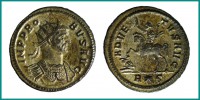
Probus (RIC 157, Coin #775)RIC 157, Silvered Antoninianus, Rom, 276 - 282 AD
OBV: IMP PROBVS AVG, Radiate and cuirassed bust right.
REV: ADVENTVS AVG (R * S), Probus on horseback left, raising right hand in salute, long
scepter in left hand, bound captive seated left in front of horse below raised right foreleg.
SIZE: 23.4mm, 3.86gMaynardGee06/22/19 at 23:24Pharsalos: Very nice example.
|
|

RIC 1132 VespasianÆ Sestertius, 24.45g
Lyon mint, 71 AD
Obv: IMP CAES VESPASIAN AVG P M TR P P P COS III; Head of Vespasian, laureate, r.; globe at point of bust
Rev: CAESAR AVG F DES IMP AVG F COS DES II; S C in exergue; Titus and Domitian stg. front, each with spear and parazonium
RIC 1132 (R). BMC 799. BNC -.
Acquired from Romae Aeternae, June 2019.
An iconic dynastic sestertius struck during Vespasian's great bronze issue of 71. The type was struck both at Rome and Lyon (ancient Lugdunum) and announced Vespasian's intention to found a dynasty. Mattingly in BMCRE II calls it a 'famous' type placing the figures on the reverse as Titus on the left and Domitian on the right. While that is a conventional numismatic placement for the two Caesares, here we see the figure on the right holding a parazonium an attribute of an imperator, which of the two could only be Titus. Conversely, the figure on the left is holding something smaller (a roll?) that does not appear to be a parazonium, despite the above RIC description. The reverse legend corresponds for this placement of the figures with the first half of the legend CAES AVG F DES for Domitian on the left, the second half IMP AVG F COS DES II for Titus on the right. The legend has caused confusion over the years with some numismatists creating the phantom title Designatus Imperator for Titus. The title COS is implied for Domitian after DES in the legend, a kind of numismatic shorthand if you will. Gunnar Seelentag attempted to clear up the matter up in Numismatic Chronicle, Vol 167 (2007), but doubts remain. Curtis Clay has proposed that the traditional view of Titus on the left and Domitian on the right is correct, pointing out that both are holding a parazonium, theorising Titus' is hidden behind his body with only the handle showing. His arguments in full can be read here: http://www.forumancientcoins.com/board/index.php?topic=44488.0 The reverse type itself is fairly rare with only a handful of specimens coming to market each decade, this Lugdunese specimen is much scarcer than those from Rome. Flavian dynastic types are far more common in silver.
Fantastic style with old cabinet toning. Same reverse die as Gemini IX, lot 414.
NB: Special thanks to Curtis Clay for additional numismatic information.
David Atherton06/22/19 at 23:23Pharsalos: Beautiful, tactile piece!
|
|

27 Anonymous issues. Time of Hadrian to Antoninus Pius. Rome Quadrans 117-161 ADReference.
RIC 27; C. 39
Obv.
Griffin seated right
Rev. S-C
Tripod.
2.49 gr
15 mm
9hokidoki06/22/19 at 19:12Pharsalos: Very nice example.
|
|

Crawford 513/2, ROMAN IMPERATORIAL, M. Arrius Secundus, AR DenariusRome, Moneyer Issues of the Imperatorial Period.
M. Arrius Secundus. 41 BCE.
AR Denarius (3.82g; 20mm).
Rome mint.
Obverse: M. ARRIVS - SECVNDVS; bare head, with slight beard, facing right.
Reverse: Victory honors - wreath, spear and phalera.
References: Crawford 513/2; HCRI 319; Sydenham 1084; BMCRR 4210; Arria 2; G. Lahusen, Die Bildnismunzen Der Romischen Republik, pl. 63, nos. 12 and 16 (this coin illustrated twice).
Provenance: Nomisma 59 (14 May 2019) Lot 134; Munzen und Medaillen XIX (5-6 Jun 1959) Lot 172; Munzhandlung Basel 10 (15 Mar 1938) Lot 486.
M. Arrius Secundus was likely son of Quintus Arrius, who had a victory in the Servile War against one of Spartacus’ lieutenants, but subsequently lost a battle to Spartacus himself. He was the only member of his gens to strike coins, and not much else is known about him.
The slightly-bearded, obverse portrait, while probably depicting the moneyer’s father, Quintus Arrius, also bears a striking resemblance to contemporaneous portraits of Octavian. However, without any inscription naming Caesar, a positive identification of the portrait remains debated by scholars. David Sear suggests that the portrait is deliberately ambiguous, as the political and military climate was very risky and the moneyer likely wanted plausible deniability that the portrait was Octavian. The reverse shows awards of victory granted to the moneyer’s father for his Servile War victory: a laurel wreath, golden spear and phalera (a military decoration attached to a harness and worn over a cuirass).
Carausius06/22/19 at 18:59Pharsalos: Wonderful coin, beautiful tone.
|
|

Calabria, Tarentum. Helmeted Horseman and Dolphin Rider Didrachm.Greek Italy. Calabria. 290-281-302 BC. AR Didrachm (7.80 gm, 20.4mm, 3h) of Tarentum. Helmeted horseman advancing right with spear, holding shield and two spears; ΦIΛI below (magistrate Phili). / Taras (Phalanthos) on dolphin left, holding distaff and dolphin; ΦI to l., ivy leaf & TAPAΣ to r., waves below. EF. Pegasi Numismatics Auction 121 #40. Ex M.P. Vlasto collection. Monteperano hoard. Ravel Vlasto 589 pl.XIX (this coin). D'Andrea Series XL Type 918; SNG ANS 1 #988 (same obv. die); SNG France 6.1 #1833 (same); SNG Cop 1 (Italy) #842; SNG Ash I #287; Fischer-Bossert Gp.79 #1086-1087, 1090, 1093-1096; HN Italy 934 (2); HGC 1 #800; Côte CAnaximander06/22/19 at 15:55Pharsalos: Gorgeous example.
|
|

Bruttium, Kaulonia. Apollo and Stag Stater.Greek Italy. Bruttium. 470-440 BC. AR Stater (6.71 gm, 24mm, 3h) of Kaulonia. Apollo Catharsius striding right, raising laurel branch, daimon running right on outstretched arm. Stag in right field, looking back, bucranium (wolf's head) in tree to left. / Stag standing. right, KAVΛOΝΙAΤA-M to left. VF. CNG 55 #71. Rare. SNG ANS 3 #185 (same dies); HN Italy 2049; HGC 1 #1419 var. (℞ full legend); Noe Caulonia group G #108e (same dies); SNG Lockett 588 = Pozzi 274 (same dies); SNG Cop 1 (Italy) #1714. cf. CNG 117 #22 (same dies).Anaximander06/22/19 at 15:53Pharsalos: Wonderful coin, never seen this obverse type befor...
|
|
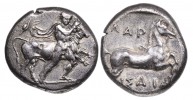
Thessaly, Larissa. Thessalos Wrestling Bull Drachm.Greece. Thessaly. 420-400 BC. AR Drachm (5.82 gm, 17.3mm, 3h) of Larissa on Aiginetic standard. Hero Thessalos standing right, petasos and chlamys over shoulder, restraining unruly bull by a band held around its head (the sport of taurokathapsia). / Bridled horse prancing right. ΛΑΡ-ΙΣΑΙΑ above and below, all in incuse square. gVF. BCD Thessaly II (Triton XV) #172 var. (same obv. die, horse r.), #372.4 var. (ethnic); HGC 4 #419/418 (same obv. die); Lorber Thessalian pl.43 #43/#53; SNG Cop 3 (Thessaly-Illyricum) #107; SNG Delepierre 1105. cf. Herrmann Group III Series J #23 var. (ethnic); Roma Numis. Auction 7 #206 (same dies).Anaximander06/22/19 at 12:48Pharsalos: Beautiful dies.
|
|
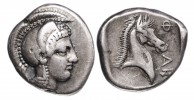
Thessaly, Pharsalos. Athena and Horse Head Hemidrachm.Greece. Thessaly. 440-420 BC. AR Hemidrachm (3.06 gm, 15.2mm, 4h) of Pharsalos on Aiginetic stdd. Head of Athena in crested Attic helmet right. / Head of horse right, Φ-ΑR (ethnic) in incuse square. VF. Pegasi Numismatics Auction XXI #96. BCD Thessaly I #664.1 (same obv. die), II 664.1 (same); HGC 4 #630; Lavva pl. 2 #31 (V21/R19); McClean II 4675, 4677 (pl.175 #11); Moustaka 51; SNG Cop 3 (Thessaly) #218 (same dies). cf. CNG EA 323 #58 (same dies).Anaximander06/22/19 at 12:47Pharsalos: Very beautiful.
|
|

0009 Thessalos Wrestling Bull Right, Horse Prancing RightThessaly Greece, the City of Larissa
Obv: The hero Thessalos1 to r. naked, except for chlamys around his shoulders and petasos, flying in the air, attached to his neck by a cord, holding with both hands a band that is around the forehead of a bull leaping r. All within a border of dots (not here visible).
Rev: ΛΑΡΙ above, Σ to the r. (not here visible), ΙΑ below (not here visible), bridled horse with trailing rein prancing r., no ground line. All within incuse square.
Denomination: silver drachm; Mint: Larissa; Date: c. 420 - 400 BC2; Weight: 6.06g; Diameter: 18mm: Die axis: 270º; References, for example: Lorber 2008, pl. 43, 59 (same dies); BCD Thessaly II 372.7 (same dies); HGC 4, 423 (same obv.).
Notes:
1Considered the ancestor of all Thessalians. The figure is also sometimes considered to be Jason (of Jason and the Argonauts), who according to one tradition was the father of Thessalos (HGC 4, p. 132).
2This is the date given in HGC 4. According to Lorber 2008 this coin should be placed in the revived bull wrestling drachm coinage, beginning c. 450 - 440 BC.
This type is related to the Thessalian sport of bull wrestling (taurokathapsia) "...regularly showcased at the Taureia games honoring Poseidon Taureios." (HGC 4, p. 132).
Provenance: Ex Shanna Schmidt Numismatics May 28, 2019; from the BCD collection, reportedly found 8 kms west of Pharsalus, May 1997.
Photo credits: Shanna Schmidt Numismatics
CLICK FOR SOURCESTracy Aiello06/05/19 at 13:24Pharsalos: Very nice example, I especially like the loose rei...
|
|

Carthage. Tanit and Stallion 1.5 Shekel of Zeugitania.Carthage. Second Punic War. c. 203-201 BC. BI Tridrachm, or 1½ Shekel (9.28 gm, 26.3mm, 12h) of Zeugitania. Wreathed head of Tanit left wearing single-pendant earrings. / Collared stallion standing right, head left, right foreleg raised. VF. SNG Cop. 8 #391-393; CNP 103; MAA 81; Müller Afrique II p.98 #230; Sear Greek II #6497.Anaximander06/05/19 at 13:09Pharsalos: Very nice example with a particularly beautiful ob...
|
|

Ionia, Teos. Griffin/Incuse Stater.Asia Minor. Ionia. c. 478-465 BC. AR Stater (11.85 gm, 24.6mm) of Teos on Aeginetic standard. Griffin with curved wing standing right, forepaw raised, footprint before, standing on pelleted exergual line. T-H-I (retrograde). Solid border. / Quadripartite incuse punch with pebbled surfaces. EF. Ponterio Auction 119 #487 (CICF 2002). Rare. Balcer cites five known examples, with one obverse & three reverse dies. Balcer Teos (SNR 47) Period II, Group XLIII #92 (A92/P124); BnF Gallica, Chandon de Briailles Coll. 574A; Weber III/1 #6203-6204; SNG von Aulock 2257. Teos founded the Thracian city of Abdera, which also used a griffin as its coin type; those of Teos face right while Abdera faced left. Anaximander06/05/19 at 13:05Pharsalos: Gorgeous coin, never knew such a control symbol ex...
|
|

Carthage. Palm Tree Litra of Zeugitania.Carthage. Zeugitania. 4th c. BC. AR Litre (0.66 gm, 9.7mm, 12h). Anepigraphic. Palm tree. / Head and neck of horse right. VF. SNG Cop. 8 (Zeugitania) #74, 1 (Sicily) #960; Falbe 1844; Müller Afrique II p. 92 #130. cf. Sear Greek 6461 var (EL).Anaximander06/05/19 at 12:43Pharsalos: Lovely and interesting.
|
|

ROMAN EMPIRE, Trajan Denarius - Vesta Seated (RIC 9)AR Denarius
Rome 98-99 AD
3.52g
Obv: Laureate head of Trajan (R), wearing aegis.
MP CAES NERVA TRAIAN AVG GERM
Rev: Vesta seated (L), holding patera and torch.
PM TRP COS II PP
RIC 9; BMC 26; RSC 203
Roma Numismatics E-Sale 55, Lot 756, 18/04/19
ex. Michael Kelly Collection of Roman Silver Coins
ex. Numismatica Ars Classica 40, Lot 696, 16/05/07Optimo Principi05/31/19 at 15:23Pharsalos: Stunning, fantastic coin.
|
|
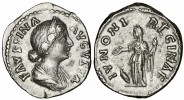
Denar, RIC 3, p.270, 695 - Faustina II, Juno, IVNONI REGINAEFaustina Minor
AR-Denar, Rome
Obv.: FAVSTINA AVGVSTA, diademed bust right
Rev.: IVNONI REGINAE, Juno veiled, standing left, holding patera and sceptre; at her feet, a peacock.
Ag, 3.30g, 17mm
Ref.: RIC III 695, CRE 193 [S]shanxi05/31/19 at 15:14Pharsalos: Great obverse, unusual drapery.
|
|
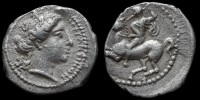
Morgantina - AR litra339-317 BC
laureate head of Apollo right
MOPΓANTINΩN
warrior on horseman left, brandishing spear, holding reins
SNG ANS 465 (same dies); SNG Copenhagen 472; HGC 2, 900.
0,80g 10,5mm
ex Roma
ex NomosJ. B.05/31/19 at 15:11Pharsalos: Very nice, beautiful dies.
|
|

0002 Sextus Pompey -- Neptune and Naval TrophySextus Pompey, Imperator and Prefect of the Fleet
[Youngest Son of Gnaeus Pompeius Magnus (Pompey the Great)]
Obv: [MAG or MA (ligatured) G]⦁PIVS⦁IMP⦁ITER; Portrait of Neptune facing r., diademed and bearded, trident over l. shoulder. Border of dots.
Rev: [PRAE (AE ligatured) F⦁CLAS⦁ET⦁ORAE (AE ligatured)]⦁MAR (ligatured) IT⦁EX⦁S⦁C⦁; Naval trophy with trident on top and anchor on bottom, prow stem on l. and aplustre on r., at base two representations of Charybdis and two dog heads of Scylla. Border of dots.
Denomination: silver denarius; Mint: Sicily, uncertain location1; Date: summer 42 - summer 39 BC2; Weight: 3.89g; Diameter: 17mm; Die axis: 30º; References, for example: Sear CRI 333; BMCRR v. II Sicily 15, 16, and 17 variant3; Sydenham 1347 variant3; Crawford RRC 511/2a or 2b4.
Notes:
Obverse legend: MAG[NUS]⦁PIVS⦁IMP[ERATOR]⦁ITER[UM]
Reverse legend: PRAEF[ECTUS]⦁CLAS[SIS]⦁ET⦁ORAE⦁MARIT[IMAE]⦁EX⦁S[ENATUS]⦁C[ONSULTO]
1Sear CRI, Crawford RRC, Sydenham, and DeRose Evans (1987) all place the minting of this coin type in Sicily, but they do not reference a possible location. Grueber BMCRR v. II Sicily suggests Messana.
2This is the date range argued for in Estiot 2006 (p. 145). Estiot recommends returning to Crawford's proposal of 42 - 40 BC. Crawford RRC, p. 521 suggests the period in 42 BC after Sextus Pompey defeated Q. Salvidienus Rufus. Grueber BMCRR v. II Sicily, p.562 proposes 38 - 36 BC and Sydenham, p. 210 adopts the same datation. DeRose Evans (1987), p. 129 offers a time between late summer 36 and September 36 BC.
3Grueber BMCRR v. II Sicily 15, 16, and 17 and Sydenham 1347 only list a reverse legend containing MAR (ligatured) I but the coin here is MAR (ligatured) IT.
4It is impossible to see the full obverse legend, so it cannot be determined if MA is ligatured or not. The reverse legend is clearly the first variety of 2a or 2b, a variety not found on 2c.
Provenance: Ex Shanna Schmidt Numismatics April 11, 2019; from the collection of W. F. Stoecklin, Amriswil, Switzerland; acquired from Hess AG in Luzern, from the Ernst Haeberlin collection, Cahn & Hess, Frankfurt, July 17, 1933 Lot 2889.
Photo credits: Shanna Schmidt Numismatics
CLICK FOR SOURCESTracy Aiello05/31/19 at 15:09Pharsalos: Lovely coin and provenance.
|
|

Roman Empire, Macrinus Denarius - Macrinus Seated Holding Globe (RIC 27a)AR Denarius
Rome, March-June 218 AD
2.89g
Obv: Laureate and draped bust of Macrinus (R).
IMP C M OPEL SEV MACRINVS AVG
Rev: Macrinus, togate, seated (L), holding globe and parazonium or sceptre.
P M TR P II COS P P
RIC 27a; BMC 47; RSC 51
Leu Numismatik Auction 4, Lot 680, 25/05/19
Ira & Larry Goldberg Coins & Collectibles Auction 106, Lot 1565, 04/09/18
ex. William Mills Collection of Roman CoinsOptimo Principi05/31/19 at 15:07Pharsalos: Beautiful, great details.
|
|

Carian Islands, Rhodes. Plinthophoric Drachm.Asia Minor. Caria. 88-85 BC. AR Drachm (3.36 gm, 16.1mm, 12h) of Rhodes, Plinthophoric series. Radiate head of Apollo Helios right. / P-O flanking rose in bloom, kerykeion (caduceus) to left. ΚΑΛΛΙΞΕΙΝΟΣ (magistrate Kaleizenos). EF. HGC 6 #1461; Jenkins Rhodian Group E #244; SNG Cop 5 (Caria) #819 var ("winged caduceus"); SNG Keckman 684 = HNOnline (Rhodes) 157 (specimen #2); BMC (Rhodus) 267.Anaximander05/31/19 at 14:57Pharsalos: Beautiful example of the type.
|
|
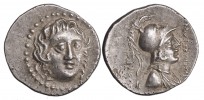
Caria, Satraps. Apollo Helios & Helmeted Athena Drachm of Halicarnassus. Asia Minor. Caria, Satraps. 1st C. BC. AR Drachm (4.39 gm, 19.9mm, 12h) of Halicarnassus. Head of Apollo Helios facing slightly right. / Helmeted bust of Athena right, draped w/ aegis. ΜΣΧΙΩΝ - ΑΛΙΚΑΡΝΑΣΣΕΩΝ. aEF. Bt. Herakles Numismatics, 2007. Ex-Gemini Auction III#195 (9 Jun 2007). SNG Kayhan 762 (same rev. die). Cf SNG Cop 5 (Caria) 367.Anaximander05/31/19 at 14:56Pharsalos: Gorgeous, what a coin.
|
|

3805 SYRIA Laodicea ad Mare. Hadrian Tetradrachm 123-24 AD Tyche Reference.
RPC III, 3805/6; Prieur 1109; Adra 1562-5; Paris 1157
Issue Year 170 (OP)
Obv. ΑΥΤΟΚΡ ΚΑΙСΑΡ ΤΡΑΙΑΝΟС ΑΔΡΙΑΝΟС СΕΒΑСΤ
Laureate and cuirassed bust of Hadrian right, with gorgoneion on breastplate
Rev. ΙΟΥΛΙΕωΝ ΤωΝ ΚΑΙ ΛΑΟΔΙΚΕωΝ
Turreted and draped bust of Tyche, right; in field, right, ΟΡ soldiers arming the battlements/towers on Tyche's head
13 gr
25 mm
12h
Note.
From the Michel Prieur Collection. Ex Robert O. Ebert Collection (Part I, Stack’s Bowers & Ponterio 174, 11 January 2013), lot 5142; Numismatica Ars Classica 1 (39 March 1989), lot 862; Münzen und Medaillen AG FPL 279 (August 1967), no. 40.okidoki03/04/19 at 11:43Pharsalos: Amazing coin, the turret engraving is spectacular.
|
|

CAMPANIA, NeapolisCAMPANIA, Neapolis. Circa 300-275 BC. AR Nomos (19mm, 7.11 g, 3h). Diademed head of nymph right; X behind / Achelous Sebethos as a man-headed bull walking right; above, Nike flying right, placing wreath on bull's head; EΥΞ below. Sambon 477; HN Italy 579; SNG ANS 372 (same dies). Near VF, toned. Ex. CNG 84, Lot. 52. From the Colin E. Pitchfork CollectionMolinari03/04/19 at 08:58Pharsalos: A beautiful example.
|
|

IONIA, CHIOSCa 400-380 BC
AR Drachm 13 mm, 3.63 g
O: Sphinx seated left; amphora surmounted by grapes to left
R: Quadripartite granulated incuse square
Chios; BMC 17-8
ex Roma Numismatics auctionlaney03/03/19 at 10:34Pharsalos: Great example of a very desirable type.
|
|

Salonina, PietasSalonina
AE Antoninianus; 19-21mm; 3.66g
Siscia mint
SALONINA AVG,
diademed draped bust right on a crescent
PIETAS AVG,
Pietas standing left by altar, holding patera.
Cohen 79; RSC 79; Sear 10646. arizonarobin03/03/19 at 10:25Pharsalos: Great coin, I love the unusual portrait.
|
|

Roman Diocletian FollisAE Follis.
Obv. DN DIOCLETIANO FELICISSIMO SEN AVG ; laur. bust r., wearing mantle, and holding branch and mappa ;
Rev.: PROVIDENTIA DEORVM QVIES AVGG ; Quies and Providentia stg. facing each other.
Dot in outer right field. Mintmark PT.
(issued after the abdication)
RIC VI Ticinum 56a; Sear 12930.Tanit03/03/19 at 10:19Pharsalos: A beautiful example, what wonderful surfaces!
|
|

Larissa, DrachmDenomination: Drachm
Era: After c. 356-340 BC
Metal: AR
Obverse: Head of the nymph Larissa facing slightly left
Reverse: ΛΑΡΙΣ / ΑΙΩΝ Horse to right, preparing to roll over.
Mint: Larissa
Weight: 6.08 gm.
Reference: Sear, Europe 2120
Provenance: CNG direct purchase.
Well centered and AEF.
03/03/19 at 10:16Pharsalos: A very beautiful example.
|
|

03 Constantius IIConstantius II
Antioch
5.2 g / 24 mm
obverse D N CONSTAN-TIVS P F AVG, pearl-diademed, draped and cuirassed bust right;
reverse FEL TEMP RE-PARATIO, Gamma in left, soldier spearing Horseman,hair in braids, bearded, reaching back towards soldier
ANZ Antioch 122
Sear 18170Randygeki(h2)03/03/19 at 10:13Pharsalos: Wonderful example, the soldier especially is very ...
|
|

Seleukid Kingdom, Seleukos I Nikator, 312-281 BC, AR Tetradrachm – SardisHead of Herakles r. wearing lion-skin headdress.
ΒΑΣΙΛΕΩΣ ΣEΛEYKOY Zeus Nikephoros seated l., monogram on shield to l., AΣ beneath throne.
SC 3.1; HGC 9, 16a; Miller & Hoover AJN 22 (2010), 8 (this coin) dies A1/P2; WSM 1350 P2 β, A1/P2 (this coin). Seleukos’ military mint at Sardis 282-281 BC.
(25 mm, 17.07 g, 12h).
Naville Sale XV (2 Jul. 1930), lot 1061.
This coin was struck in 282 BC following the fall of the city of Sardis to Seleukos, during the preliminaries of the campaign that delivered the decisive victory over Lysimachos at Korupedion, in the late summer of 281 BC. This coin is from the first obverse and second reverse die used in the series. It is one of two examples from this die set that survives to this day. The series from which it comes was interpreted by Miller and Hoover (The Sardes Mint under Seleucus I Nicator) to have originated from a military mint operation associated with Seleukos army. The obverse bears a striking resemblance to the last die used at Seleukeia in Pieria, to the extent that both dies were almost certainly engraved by the same hand. This led Miller and Hoover to propose that "Stylistic affinities between the first die of Sardes and the last of Seleucia in Pieria raise the possibility that the equipment and personnel of the latter may have been moved to Sardes to serve as a supplemental military mint."n.igma01/17/19 at 07:23Pharsalos: Superb artistic dies matched with a nice provenanc...
|
|

PROBUS MPR 355 OBVERSE: IMP PROBVS AVG
REVERSE: VICTORIA GERM
BUST TYPE: B (BASTIEN'S CLASSIFICATION)
FIELD / EXERGUE MARKS: --//RᴗA
WEIGHT 3.59g / AXIS: 11h / WIDTH 21-23,5mm
RIC: 222
J.GUILLEMAIN, MONETAZIONE DI PROBO A ROMA (276-282 d.C.), 2009: 355 (61 EX.)
COLLECTION NO. 512Barnaba601/15/19 at 12:48Pharsalos: Fantastic details.
|
|
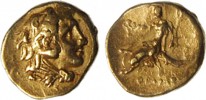
CALABRIA. Taras. Time of Pyrrhus (ca. 280 BC). AV 10th stater11mm, 0.85 gm, 5h
Head of young Heracles right, wearing lion skin headdress / TAPAΣ, Taras astride dolphin left, holding cantharus in extended right hand and trident cradled in left arm.
Vlasto 43. SNG ANS 1401. HN Italy 992.
Very rare! Exceptionally well struck and pleasing, with reddish tone in deep recesses.Leo01/15/19 at 12:41Pharsalos: Congratulations, that is rare and very interesting...
|
|

Greek, Catalogue of the Collection of Tarentine Coins formed by M. P. Vlasto #140CALABRIA, Taras. Circa 470-465 BC. AR Nomos
18.5mm, 8.05 g, 7h
Taras, nude, raising left hand and supporting himself with his right, riding dolphin right; TARAS (retrograde) to left, scallop shell below / Head of nymph (Satyra?) left in linear circle within concave incuse. Fischer-Bossert Group 5, 91b (V41/R60) = Vlasto 140 (this coin, illustrated in both references); HN Italy 838; Berlin 65 (same dies). VF, old cabinet tone, a few marks.
From the Gasvoda Collection. Ex M. L. Collection of Coins of Magna Graecia and Sicily (Numismatica Ars Classica 82, 20 May 2015), lot 4; A. D. Moretti Collection; Classical Numismatic Group 40 (with Numismatica Ars Classica, 4 December 1996), lot 575; Hess-Leu [11] (24 March 1959), lot 5; Kricheldorf IV (7 October 1957), lot 26; Münzen und Medaillen AG VIII (8 December 1949), lot 696; Michel Pandely Vlasto Collection; Maddalena Collection (Sambon & Canessa, 7 May 1903), lot 244.Leo01/15/19 at 12:26Pharsalos: Very interesting and wonderful provenance!
|
|

Parthia - Orodes II (57-38 BCE)Metal/Size: AE12; Weight: 3.0 grams; Mint: Unknown; Denomination: Chalkous; Date: 57-38 BCE; Obverse: Short-bearded bust left wearing diadem and pellet-ended torque; circular border of pellets; hair in 4/5 rows, wart present on brow. Reverse: Double-humped camel sitting right; no border; seven-line Greek inscription = ΒΑΣΙΛΕΩΣ ΒΑΣΙΛΕΩΝ ΑΡΣΑΚΟΥ ΕΥΕΡΓΕΤΟΥ ΔΙΚΑΙΟΥ ΕΠΙΦΑΝΟΥΣ ΦΙΛΕΛΛΗΝΟΣ (("King of Kings Arsaces, Beneficent, Just, Illustriously born, Lover of Greece"). References: Sellwood #45 variant.museumguy01/15/19 at 12:19Pharsalos: Awesome, never seen this type before.
|
|

Crawford 039/1, ROMAN REPUBLIC, Collateral Semilibral Struck AE TriensRome. The Republic.
Semilibral Reduction, 217-215 BCE
Æ Triens (54 grams; 37 mm).
Uncertain Italian Mint.
Obverse: Head of Juno (?) right, wearing double-crested diadem, her hair tied in three ringlets down neck; scepter or sword over left shoulder (?); ●●●● (mark of value) behind.
Reverse: Hercules, naked but for lion skin, grasping centaur by hair and preparing to strike him with club; ●●●● (mark of value) before; ROMA in exergue.
References: Crawford 39/1; Sydenham 93 (R6); BMCRR (Romano-Campanian) 113-115.
Provenance: Ex Munzen und Medaillen 47 (1972), Lot 74.
Crawford dates his 39 series of collateral, semilibral struck bronzes to the early years of the Second Punic War, 217-215 BC. The economic hardship on Rome imposed by Hannibal’s invasion led to a rapid decline in the weight of Roman bronze coins, resulting in the adoption of a semi-libral bronze standard (AE As of ½ Roman pound) and eventual elimination of cast coins. Crawford deduces that Hannibal’s defeat of Rome at Trasimene in 217 B.C. likely tipped the financial scales to the semilibral reduction. He notes that Capua overstruck Roman coinage of the late semi-libral period when Capua joined with Hannibal in 216-215. Further, in Roman Republican Coin Hoards, Crawford reports that hoard #56, found at Capua in 1909, contained three trientes and four sextantes of the “collateral” series; thus the series must have circulated in Capua for a time before the town switched sides to Hannibal in 216-215. It appears that the standard, prow-type semilibral coins (Crawford 38) came first, because hoards containing the Crawford 39 coins almost always contain semilibral prow types as well.
The obverse of this Triens is particularly enigmatic. Both before, during and after production of this series, the goddess depicted on trientes was typically Minerva. In Roman iconography, Minerva’s attributes are the Corinthian helmet, aegis and spear. The goddess on this triens lacks the Corinthian helmet that was used to depict Minerva in previous Aes Grave series of libral and semilibral weight standard (See Crawford 35 and 38 Aes Grave) and on the subsequent, prow-type, struck trientes (Crawford 41 and 56). Some authors are non-committal as to the goddess’ identity (Crawford, for one, in his catalogue; though elsewhere in his text he refers to “Juno”); others attribute the goddess as Juno who, as Jupiter’s consort, is typically rendered with a diadem crown and scepter; and others believe the goddess is Bellona, a war goddess who is typically rendered with helmet and weapon. Firm identification depends, in part, on proper understanding of the headgear. I think attempts to call the headgear a “helmet” or “partial helmet” are misguided efforts to explain the crest. In my opinion, the headgear is a crested diadem. The odd crest attached to the end of the diadem is possibly a misinterpreted element borrowed from portraits of Tanit on Punic coinage, which always show Tanit with a stylized wheat leaf in this location (Tanit’s depiction was likely borrowed by the Carthaginians from Syracusan tetradrachms). There is also some confusion as to what the goddess holds over her left shoulder. Condition issues and poor strikes on some examples often eliminate this aspect of the design. Fortunately, my example is quite clear and one can see the shadowy image on the left shoulder which extends in straight-line behind the left side of the goddess’ head ending in a visible, rounded point above her head. Crawford may have thought the lower part of this element represented the goddess’ far-side curls (“hair falls in tight rolls onto BOTH shoulders” emphasis added), but this interpretation does not explain the point above her head. The point is not likely to represent the opposite crest, as the crest on the visible side does not extend above head-top level. A more plausible theory, proposed by both Grueber and Sydenham, is that the goddess is holding a scepter over her left shoulder, which is consistent with Juno’s attributes. Other possibilities are that she bears a spear, which is an attribute of Minerva, or a sword, which is an attribute of Bellona.
The Series 39 types and their relationship to contemporaneous Second Punic War events are interesting to ponder. Hercules is an important figure, appearing on two of the 10 available sides of the series. Likely this is a paradigm of Roman heroism during the War. In the myth depicted on this Triens, Hercules kills a centaur for assaulting his wife – is this an allegorical reference to Hannibal’s assault on Italy (and the likely response from Rome)?
Despite its beauty, this type would never again be repeated on a Roman coin. However, related imagery can be found on quincunxes of Capua and quadrantes of Larinum, Apulia, immediately following the defection of those towns to Hannibal’s side of the Second Punic War.
Carausius11/28/18 at 08:03Pharsalos: Wow, spectacular.
|
|

EB0061 Artemis / BullIonian Islands, Island of Ikaros, Oenoe AR Drachm. 3rd century BC.
Obverse: Head of Artemis ¾ right.
Reverse: IONAI below bull butting right.
References: Sear 4620.
Diameter: 16mm, Weight: 3.465g.EB11/28/18 at 08:00Pharsalos: Beautiful!
|
|

Roman Empire, CONSTANTIUS GALLUS CAESAR. AE2 Maiorina or Centenionalis of Antioch. Struck A.D.351 - 354Obverse: D N CONSTANTIVS NOB CAES. Bare-headed draped and cuirassed bust of Constantius Gallus facing right.
Reverse: FEL TEMP REPARATIO. Soldier advancing left, spearing fallen horseman, discarded shield on ground at feet; in left field, Γ : in exergue, ANH.
Weight 5.6gms
RIC VIII: 134 *Alex10/26/18 at 08:34Pharsalos: Wow! That reverse is superb, even by Antioch's...
|
|

KINGS OF MACEDON. Philip II, 359-336 BC. StaterGold, 19 mm, 8.56 g, 11 h
Pella, struck under Philip II or Alexander III, circa 340-328.
Laureate head of Apollo to right. Rev. ΦΙΛΙΠΠOY Charioteer driving biga to right, holding reins in his left hand and goad in his right; below horses, trident right.
Le Rider 320 (D145/R244). Several nicks and small scrapes , otherwise, good very fine. From a Viennese collection, formed in the 1990s.Leo10/24/18 at 11:19Pharsalos: Awesome.
|
|

ATTICA, Athens. Circa 454-404 BC. AR Tetradrachm(24mm, 17.20 g, 2h).
Helmeted head of Athena right, with frontal eye / Owl standing right, head facing; olive sprig and crescent behind; all within incuse square. Kroll 8; HGC 4, 1597. Good VF, toned. Attractive early style.
This tetradrachm belongs among the earlier period of the “frontal eye” issues of the mid-late 5th century. The palmette is still delicate, as is the general style of the owl, and the incuse is rather deep and abruptly transitions to the flat surface.Leo10/24/18 at 11:16Pharsalos: Magnificent!
|
|

CALABRIA. Taras. 425-380 BC. AR nomos6.26 gm
Nude ephebe cantering left, holding bridle with both hands, ΛΕ (retrograde) beneath horse / TARAS, dolphin rider right, wielding trident and pointing with left hand.
HN Italy 850. Vlasto 319 (same dies).
Porous. Edge bump (8:00 obverse) and reverse scratches. Good very fine.
The aristocratic Tarentines were especially proud of their reputation as first-rate horsemen, and the coinage of Tarentum mirrors this pride by displaying all manner of equestrian showmanship. Some of the riders appear in full armor, and those must be cavalrymen in battle, but most appear nude: those riders are surely taking part in the various races and games that the aristocrats loved so much. One of the more dangerous, and most prestigious, of the races was the kalpé. In this form of race the rider would, at a certain stage, slide off his horse and, while holding the reins, run along side. The Tarentine staters show several stages in the process. On this coin we see the very beginning: the rider places his left hand on the horse’s rump and has moved his right hand from the right to the left side of the his horse’s head. On the next lot we see him moving his right leg up over the horse’s back; on other coins (not here) we see both legs stretched out on the left side of the horse just before the rider leaps to the ground. For a short discussion of this event see Sport, p. 79. The actual process of getting off the horse was termed apobates. There are many examples of the initial stages of the apobates to be found in this rich collection.Leo10/24/18 at 11:10Pharsalos: Exceptional dies, I've never seen one like thi...
|
|

CALABRIA, Tarentum. Circa 280-272 BC. AR Nomos19mm, 6.45 g, 4h
The Dioskouroi riding left; monogram above, [ΣΩ]Δ-A-M-O-Σ below
Phalanthos, nude, holding two spears, shield decorated with hippocamp, and Nike, who crowns him with wreath, riding dolphin left; ΠY to left, waves below.
Vlasto 773; HN Italy 1011. Good VF, toned, compact flan. Well centered.Leo10/24/18 at 11:05Pharsalos: Two wonderful dies and beautiful toning.
|
|

RIC 0759 VespasianÆ Dupondius, 14.46g
Rome mint, 74 AD
Obv: IMP CAESAR VESPASIANVS AVG; Head of Vespasian, laureate, l.
Rev: PON•MAX•TR•POT•P•P•COS•V CENS; Winged caduceus between crossed cornuacopiae
RIC 759 (C). BMC p. 219 note. RPC 1983 (6 spec.). BNC 905.
Ex eBay, 16 October 2018. Ex Klassische Münzen.
Traditionally, the issue this rather strange dupondius is from has been attributed to various different mints over the years. Ted Buttrey writing in the RIC II.1 Addenda commented extensively on it. Because both the Addenda has yet to see the light of day and T. Buttrey's thoughts on the subject are important (and indeed likely correct), I have largely quoted it in full here with some minor editing.
'RIC 756-767 are irregular Dupondii, which should be taken together with Asses, semisses and quadrantes (RIC 1564-1581), forming together a single extraordinary issue in four denominations, distinct in typology and metal, as well as overall character from the regular coinage of the year. Although Eastern in aspect and reverse type, the circulation area of the dupondii is almost exclusively Gaul, Germany, Italy – i.e. the West, with scarcely any penetration of the East. Finds of the smaller denominations are rarely attested anywhere, East or West. The Eastern finds appear to be simply the débris of Mediterranean circulation.
Previously the series had been attributed to Commagene (BMCRE II, pp.217-222), then as a likelihood to Antioch (e.g. RPC II 1982-2005). The correct attribution to Rome is proved by mules of the dupondii with regular issues (Buttrey, “Vespasian’s Roman Orichalcum: An Unrecognized Celebratory Coinage” in David M. Jacobson and Nikos Kokkinos, Judaea and Rome in Coins, 65 CBE – 135 CE (2012). The series had nothing to do with Syria or with the East at all, yet it was purposefully designed to appear non-Roman: the suppression of the traditional reverse sub-inscription S C throughout; the suppression of the radiate crown of the Dupondius; the shifting of the consular dating from the obv. to the rev.; the striking of all four denominations in orichalcum; and most obviously the selection of rev. dies which reek of the East.
There is nothing like this series in the whole of Roman imperial coinage. It is a deliberate act of Orientalism, imposing the flavour of the East on a Western coinage. The key to its understanding is the reverse type of the dupondius, two crossed cornuacopiae with a winged caduceus between. It replicates the type of an obscure issue of the Galilean city of Sepphoris, an issue which had been, astonishingly, signed by Vespasian himself (ΕΠΙ ΟΥΕCΠΑCΙΑΝΟΥ, “on the authority of…”) when on duty there in the last days of Nero. The dupondius-sized bronze was accompanied by a half-unit with the type of a large, central S C – again signed by Vespasian, and now imitated on the As of the orichalcum series with the wreath of the As of Antioch (RPC I 4849-50).
The whole of this series memorializes not Vespasian the conquering general (IVDAEA CAPTA, VICTORIA AVGVSTI), but the man. His re-use of earlier coin types is well-known; here he re-uses his own, harking back to his career just prior to his final success in seizing the empire. And the series was struck in 74 A.D., co-terminous with the celebration of Vespasian’s first quinquennium.'
The coin itself is a superb example in very fine style. Beautiful dark golden patina with highlights of emerald green. David Atherton10/24/18 at 11:04Pharsalos: Great coin, beautiful and very honest surfaces.
|
|

Amisos, Pontos300 – 125 B.C.
Silver Siglos (reduced)
3.83 gm, 15 mm
Obv.: Draped bust of Hera-Tyche right, wearing turreted stephane
Rev.: Owl facing with spread wings standing on shield; monogram to lower left.
SNG Black Sea 1110 var. (monogram);
HGC 7, 233
Jaimelai10/24/18 at 11:00Pharsalos: Very nice example
|
|

Ionia, Miletos, (cc.350-250 B.C.), AR-Hemidrachm, Deppert-Lippitz 58 (V27/R33)(?), Lion standing left, star above, #1Ionia, Miletos, (cc.350-250 B.C.), AR-Hemidrachm, Deppert-Lippitz 58 (V27/R33)(?), Lion standing left, star above, #1
avers: Laureate head of Apollo left.
reverse: Lion standing left, star above.
exergue: -/-//--, diameter: 10,0 mm, weight: 1,69g, axes: 0 h,
mint: Ionia, Miletos, date: cc.350-250 B.C., ref: Deppert-Lippitz 58 (V27/R33)(?).
Q-001quadrans10/24/18 at 10:55Pharsalos: Very nice coin.
|
|

Campania, Neapolis, (275-250 B.C.), AE-18 (Obol), SNG ANS 488var. (O behind), Man-headed bull left and flying Nike, #1Campania, Neapolis, (275-250 B.C.), AE-18 (Obol), SNG ANS 488var. (O behind), Man-headed bull left and flying Nike, #1
avers: Laureate head of Apollo left, O behind
reverse: Man-headed bull standing right, being crowned by Nike who flies above, IS in exergue.
exergue: -/-//IS, diameter:18,0mm, weight: 6,21g, axes: h,
mint: Campania, Neapolis, date: 275-250 B.C., ref: SNG ANS 488var. (O behind); Rutter, HN 589.
Q-001quadrans10/24/18 at 10:44Pharsalos: Wonderful dies, it's a beautiful coin.
|
|

1037 Sabina As Roma 128-136 AD ConcordiaReference.
RIC 1037; BMC 1891; C. 19; Strack 863
Obv. SABINA AVGVSTA HADRIANI AVG P P
Diademed and draped bust right
Rev. CONCORDIA AVG / S C.
Concordia seated left on throne, holding patera and resting elbow upon statue of Spes; cornucopia below throne.
11.13 gr
27 mm
6hokidoki10/12/18 at 14:14Pharsalos: Stunning!
|
|

EB0006 Nymph / Man-headed bullNeapolis, CAMPANIA, AR Nomos/2 drm., 300-281 BC.
Obverse: Diademed head of nymph left, wearing earring and necklace.
Reverse: Man-headed bull walking left, crowned by Nike above flying left.
References: Cf. GROSE 269,3 (also see SNG ANS 350-381).
Diameter: 20mm, Weight: 7.312g.EB10/12/18 at 14:11Pharsalos: Beautiful dies! Very nice coin.
|
|

Attica, Athens, Athena, Owl, TetradrachmAttica. Athens
Silver tetradrachm, ca. 454-404 BC
Av: Helmeted head of Athena right, with frontal eye.
Rv: AΘE. Owl standing right, head facing; olive sprig and crescent to left; all within incuse square.
AR, 17.16g, 23mm
Ref.: Kroll 8; HGC 4, 1597.shanxi10/12/18 at 13:18Pharsalos: Fantastic coin, both sides.
|
|
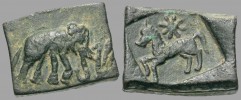
Taxila: Anonymous (185-168 BCE) Æ 1 1/2 karshapana (AICR 1083-4; MACW 4404-7; HGC 12, 774)Obv: Elephant advancing right; before, plant
Rev: Horse prancing left; above, star
Dim: 20x15 mm, 9.51 g, 12 h Quant.Geek10/12/18 at 13:14Pharsalos: Excellent example.
|
|
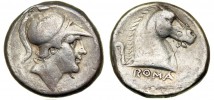
Crawford 25/1 DidrachmDenomination: Didrachm
Era: c. 241-235 BC
Metal: AR
Obverse: Helmeted head of beardless Mars r. Helmet decorated with gryphon.
Reverse: Horse’s head r.; behind, sickle; below truncation, ROMA.
Weight: 6.57 gm.
Reference: Crawford 25/1
Provenance: Goldberg 69 lot 3233, 31-MAY-2012
Comments: Both sides centered, but slightly short flan leaves no trace of border on either side. Tiny obverse planchet void below chin; almost imperceptible fine cleaning marks below ROMA on reverse. Otherwise, strong VF.
10/12/18 at 13:13Pharsalos: Beautiful style, I love it.
|
|

1358 Hadrian, Cistophorus IONIA Smyrna Zeus seatedReference.
RPC III, 1358; Metcalf 29
Obv. HADRIANVS AVGVSTVS P P
Bare head right
Rev. COS III
Zeus seated l. on throne holding small image of Ephesian Artemis in r. and sceptre in l.; to l., eagle
10.72 gr
29 mm
12hokidoki10/12/18 at 13:05Pharsalos: Very cool coin, same diameter as his sestertii!
|
|

Crawford 410/8, ROMAN REPUBLIC, Q. Pomponius Musa, AR DenariusRome, The Republic.
Q. Pomponius Musa, mid-50s BCE
AR Denarius (3.98g; 19mm).
Rome Mint.
Obverse: Laureate head of Apollo(?), hair tied-up, facing right; star behind.
Reverse: Q. POMPONI – MVSA; Urania, muse of astronomy, facing left, holding wand over globe on tripod.
References: Crawford 410/8; Sydenham 823; Pomponia 22.
Provenance: Ex William C. Boyd (d. 1906) Collection [Baldwin's 42 (26 Sep 2005), Lot 64]; bought from Spink in 1900.
Q. Pomponius Musa, who punned his name by depicting the Muses on a series of coins, is unknown except for his coins, which makes precise dating of the series difficult. For many years, scholars (including Crawford) dated the series to 66 BCE. However, the absence of any examples of the series in the large Mesagne hoard caused Hersh and Walker to bring down the date of the series to 56 BCE. Michael Harlan, retracting his reticence with the Mesagne dating, later proposed a date of 52 BCE.
There are two varieties of Musa denarii: the first depicts Apollo/Hercules Musarum (see my gallery example); the second, of which there are nine sub-varieties, depict Apollo and a Muse. The above coin is of the second variety.
Apollo is often depicted androgynously on ancient coins. The standard references consistently attribute the obverse heads on both varieties of Musa’s coins as Apollo; but the depictions are notably different between the Hercules Musarum variety and the nine Muse varieties. On Hercules variety, the deity’s hair is down and tied, and generally consistent with many depictions of Apollo on other Roman Republican coins (see, e.g., denarii of L. Calpurnius Piso and C. Calpurnius Piso). Comparatively, the head on the above Muse variety is considerably more feminine in appearance and laureate, though lacking earrings, necklaces or other feminine accents. Admittedly, this more feminine type head has also been attributed by scholars as Apollo on other coin types (see, e.g., denarii of P. Clodius and C. Considius). However, within the same series the different styled heads appear to depict different deities. Given the Muse emblems behind each head on the nine Muse types, it’s possible that the feminine heads do not represent Apollo, but the Muses themselves. Michael Harlan agrees with this interpretation in both editions of "Roman Republican Moneyers and their Coins." More research on this issue is needed.
Carausius10/12/18 at 12:59Pharsalos: Magnificent example with a provenance to match.
|
|
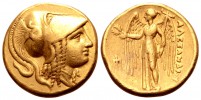
Kingdom of Macedon, Alexander III 'the Great' AV Stater8.57g, 18mm, 1h.
Amphipolis, circa 307-300 BC. Head of Athena right, wearing Corinthian helmet decorated with a serpent on the bowl / Nike standing left, holding wreath and stylis; trident head pointing downwards in left field, AΛEΞANΔPOY to right.
Price 172.
Very Fine.Leo10/12/18 at 12:56Pharsalos: Very impressive, congratulations.
|
|
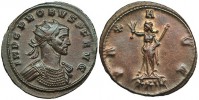
RIC 706RIC 706; Alföldi type 41, n° xx; Siscia. Bust type F, (B). Denomination: Antoninianus.
OBV.: IMP C PROBVS P F AVG
Radiate, cuirassed bust right.
REV.: PAX AVG
Pax standing left, holding olive-branch and sceptre.
Mintmark: // XXIV
Weight: ?
Diameter: ?
Die Axis: ?
Ex Dattarivrtsprb10/12/18 at 12:52Pharsalos: Beautiful patina.
|
|
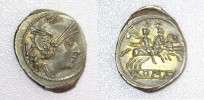
Quinarius, Crawford 47/1Denomination: Quinarius
Era: c. 211 BC
Metal: AR
Obverse: Helmeted head of Roma r. Behind, “V” . Border of dots
Reverse: Dioscuri r.; in linear frame. “ROMA”. Line border
Weight: 2.29 gm.
Reference: Crawford 47/1a
Provenance: Private purchase from Edward Waddell 11-AUG-2010
Comments: This quinarius from an uncertain mint is characterized by it’s splayed visor of three lines with the longest line on top. Very similar to Cr. 44/6, but of a distinctly different style on both obverse and reverse. Near mint state on a slightly ovoid flan.10/12/18 at 12:49Pharsalos: Very pretty.
|
|
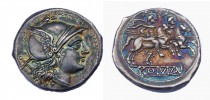
Denarius Crawford 80/1bDenomination: Denarius
Era: c. 209-208 BC
Metal: AR
Obverse: Helmeted head of Roma r. with peaked visor. Behind, “X”. Border of dots
Reverse: Dioscuri r.; in linear frame. “ROMA”. Line border
Mint: Sicily (?)
Weight: 3.65 gm.
Reference: Crawford 80/1b
Provenance: Auctiones E-Auction #5, 15-APR-2012
Comments: RRC suggests these are the anonymous sibling of the dolphin symbol series; however I believe this is a separate issue. The anonymous coins are consistently of finer style than the symboled coins. The dolphin symboled examples have a somewhat crude style which is unique to the issue, but is rarely seen on the fully anonymous coins (There are occasional exceptions to this. See the next coin in the collection).
Nearly complete and EF with iridescent toning in the recessed areas.
10/12/18 at 12:37Pharsalos: Wow, beautiful coin.
|
|

Campania, Phistelia, SNG France 1134Phistelia, c. 325-275 BC
AG - Obol, 0.61g, max. 10.5mm, 180°
obv. Female head facing, slightly l.
rev. Lion with raised tail walking l.
in ex. snake in one coil l.
ref. SNG ANS 584; SNG France 1134; Rutter p.180, Group IV; HN Italy 619
VF, toned, small flan crack at 4 o'clock, some scratches
Pedigree:
ex CNG Sale XXI (9./10. 9. 1994), Lot 21
ex coll. David Herman
ex CNG e-auction (20. 9. 06), Lot 93
ex coll. Jyrki Muona
From Forum Ancient Coins, thanks!
Phistelia was apparently among those Samnite cities which were destroyed by Sulla and vanished. At present it is known only by its coins.Jochen07/28/18 at 07:45Pharsalos: Beautiful little coin!
|
|

1960 Hadrian Sestertius Roma 130-38 AD Hadrian on horsebackReference.
Banti 296 (this coin); RIC II, 935; C. 585 var. (same); BMCRE 1689 var. (same); Strack 809; Hill 887; RIC 1960
Bust C2+
Obv. HADRIANVS COS III P P
Bare head, draped bust viewed from side
Rev. EXERCITVS SYRIACVS / SC in ex.
Hadrian, holding sceptre, riding left with hand raised is gesture of address, towards a crowd of three soldiers with standards
28.20 gr
31 mm
6h
Note.
Ex Monsieur Note (1910-1982) Collection, France.= Lanz 18 1980=Banti 296okidoki06/30/18 at 00:50Pharsalos: That is a fantastic coin! Interesting rare type, w...
|
|

Taras diobolCALABRIA. Taras. Ca. 325-280 BC. AR diobol (1.09 gm).
Head of Heracles facing slightly to the left, wearing lion-skin headdress / Heracles standing right, strangling the Nemean lion. HN Italy 977. SNG Copenhagen 995. Vlasto 1349. Toned. Somewhat weakly struck, but otherwise Extremely Fine.
Leo06/15/18 at 13:25Pharsalos: Magnificent obverse die.
|
|

146 Constans (333-337 A.D. Caesar, 337-350 A.D. Augustus), Cyzicus, RIC VIII 066, -/-//SMKA, AE-2 Follis, FEL TEMP REPARATIO, Galley, Rare !,146 Constans (333-337 A.D. Caesar, 337-350 A.D. Augustus), Cyzicus, RIC VIII 066, -/-//SMKA, AE-2 Follis, FEL TEMP REPARATIO, Galley, Rare !,
avers:- D-N-CONSTA-NS-P-F-AVG, Draped , diademed, bust right,
revers:- FEL-TEMP-REPARATIO, Emperor military dress stage left on galley, holding phoenix on globe and standard with Chi-Rho on banner, in the stern sits Victory, steering the ship. No letter on the fields !!
exe: -/-//SMKA, diameter: 23-24,5 mm, weight: 4,95g, axis: 0h,
mint: Cyzicus, date: A.D., ref: RIC-VIII-66 no letter is the fields!! Rare!, p-494,
Q-001quadrans06/15/18 at 12:36Pharsalos: Wonderful style and strike!
|
|

15. Mesembria: Tetradrachm in the name of Alexander the Great.Tetradrachm, ca 250 - 175 BC, Mesembria mint.
Obverse: Head of Alexander as Herakles, wearing lion's skin headdress.
Reverse: ΒΑΣΙΛΕΟΣ ΑΛΕΞΑΝΔΡΟΥ / Zeus sitting, holding his attendant eagle and sceptre. Monogram under throne, Corinthian helmet at left.
16.66 gm., 33 mm.
P. #1013.Callimachus06/15/18 at 12:24Pharsalos: Lovely, great strike!
|
|
|
|

|
